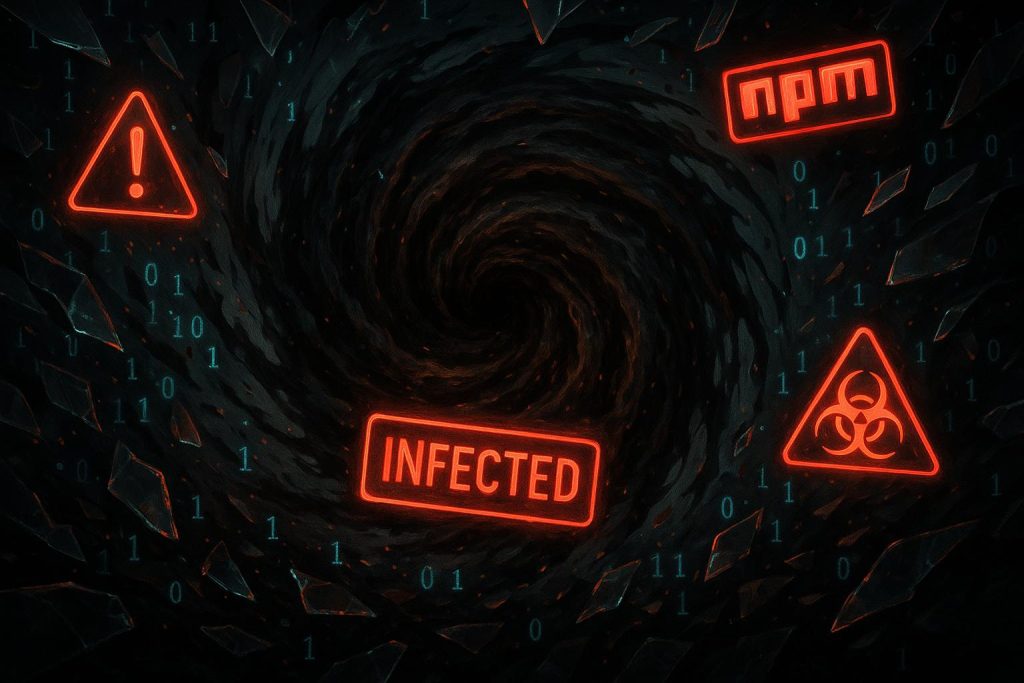Listen to the article
A sophisticated malware campaign named ‘Shai-Hulud’ has compromised over 180 npm packages, using self-propagating techniques to steal secrets and threaten the JavaScript ecosystem’s integrity.
In a significant escalation of supply chain attacks targeting the JavaScript ecosystem, over 180 npm packages have fallen victim to a sophisticated campaign named “Shai-Hulud.” First detected on September 15, this attack leverages a self-propagating worm-like malware to infiltrate developer accounts, steal sensitive credentials, and publicise private secrets across GitHub repositories. The attackers compromised more than 40 developer accounts to publish upwards of 700 malicious package versions on the npm registry, spreading rapidly through the ecosystem.
Among the targeted packages are notable ones such as @ctrl/tinycolor, with millions of weekly downloads, ngx-bootstrap, and numerous CrowdStrike packages, which were swiftly removed following discovery. The injected malicious code primarily takes the form of a post-install script that downloads and runs the TruffleHog secret scanning tool. This tool scans for secrets within installed environments, harvesting environment variables, exposed cloud credentials, and various API keys. Once identified, particularly GitHub tokens, the malware exploits them to create public GitHub repositories where stolen secrets are dumped, and it can convert private repositories into public ones bearing the label ‘Shai-Hulud Migration.’
Cybersecurity firms such as Ox Security and Socket have observed that the worm-like behaviour extends beyond initial infection. The malware uses any discovered npm tokens to enumerate packages maintained by compromised accounts and publishes new malicious versions of these packages, effectively propagating itself further throughout the npm ecosystem. This self-replicating capability has led security experts to describe the campaign as one of the most severe JavaScript supply chain attacks to date.
Technical analyses reveal that Shai-Hulud predominantly targets Linux and macOS environments while intentionally avoiding Windows machines. Diverse variations of the malicious payload have been identified, some incorporating iterative enhancements like attempting to steal Azure credentials or modifying repository visibility to evade detection, according to JFrog’s findings. The malware’s extensive credential theft focuses on GitHub API tokens, npm tokens, AWS, Google Cloud, Azure credentials, Atlassian keys, and Datadog API keys.
This incident bears resemblance to the earlier s1ngularity attack, which similarly involved stolen secrets being exposed publicly via compromised accounts. Indeed, Wiz, a cloud security firm, has highlighted that initial victims of Shai-Hulud included developers previously breached during s1ngularity, suggesting a link or reuse of access.
The ramifications of such breaches can be profound. Legit Security warns that stolen credentials provide attackers with persistent footholds, enabling further malicious code injections, potential source code exposure, and escalation into cloud infrastructure environments. Additionally, GitGuardian reports that while many of the secrets leaked have been revoked, dozens—mainly GitHub API tokens—remain active, potentially allowing ongoing misuse.
Security responders recommend vigilant auditing of npm environments and GitHub accounts. Users should monitor for suspicious creation of repositories named after the Shai-Hulud campaign or any unusual branch activity, review GitHub audit logs for anomalous API calls, and immediately revoke and regenerate all tokens and credentials upon signs of compromise. Pinning dependencies to fixed versions and scrutinising package updates that appear on npm but not on GitHub are prudent defensive measures.
The attack’s scale is amplified by the interconnected nature of npm packages, where one infected package can cascade infections through dependency chains. This has affected a wide spectrum of developers and organisations, ranging from tech startups and cloud security vendors to student developers and specialised software providers across industries. Wiz underscored the severity by characterising Shai-Hulud as an unprecedented threat within JavaScript’s supply chain infrastructure.
Looking ahead, cybersecurity experts caution that as long as credentials remain exposed and attackers can automate propagation using stolen tokens, such attacks are likely to continue. Mitigation strategies involve not only reactive credential management but also proactive measures like integrating Software Bills of Materials (SBOMs) for transparency, enforcing strong multi-factor authentication and privileged access management, and implementing continuous monitoring for unusual behaviours within software environments.
The Shai-Hulud incident marks the third major compromise of the npm ecosystem in recent times, following the s1ngularity attack and the case involving Josh Junon’s widely used packages. Industry voices emphasise that these are not outliers but symptoms of broader supply chain vulnerabilities demanding urgent attention from developers and organisations alike to safeguard the integrity of modern software development.
📌 Reference Map:
- Paragraph 1 – [1], [7]
- Paragraph 2 – [1], [2], [7]
- Paragraph 3 – [1], [3], [7]
- Paragraph 4 – [1], [4], [6]
- Paragraph 5 – [1], [3]
- Paragraph 6 – [1], [4], [5]
- Paragraph 7 – [1], [4], [5], [6]
- Paragraph 8 – [1], [3], [4]
- Paragraph 9 – [1], [3], [7]
- Paragraph 10 – [1], [4], [7]
- Paragraph 11 – [1], [3], [7]
Source: Fuse Wire Services


